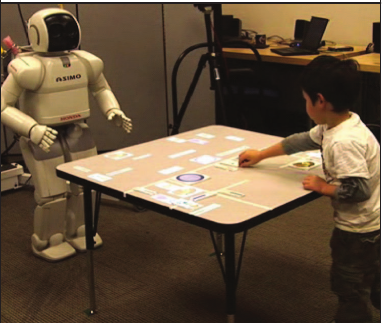Playdates with Robots
By Victor Ng-Thow-Hing and Sandra Okita
NOTE: This is an overview of the entire article, which appeared in the August 2012 issue of Computer Magazine.
Click here to read the entire article.
Editor’s Note: The IEEE Life Sciences Portal has previously posted articles on the use of robots to interact with children as an aid to therapy and/or education. This article from Computer Magazine reports on an interesting study designed to develop models for peer-based interaction of robots with children. While this study was done in the context of education, it may point to methods for improved use of robots in a wide range of interactions with children.
The authors undertook their Learning with Kids project to investigate the use of robots interacting with children in a one-to-one setting to review or explain concepts. Their project involved collaboration with roboticists at Honda Research Institute USA and with a cognitive scientist from Columbia University. It had as a goal the development of tools to help children and robots engage in learning activities and to determine how to elicit active social interaction. They enlisted volunteer children aged 4 to 12 years old to engage in game play and storytelling activities with the robot.

A robot and child playing a table-setting game.
The article describes the “Wizard of Oz” technique they used, where a hidden operator monitors and controls the robot’s speech and nonverbal communication. Use of this technique allowed them to respond more accurately to the child’s speech and body language.
They determined from their study that interacting with a cooperative robot led to the children being more involved and engaged than when the interaction was in a lecture or in turn-taking play modes. As described in the article, they also studied the effects of varying other aspects of the interaction, such as the use of a human voice versus a robot-like voice, and how the robot’s actions can influence the child to allow the robot a closer physical proximity during the interaction.
The authors report that these studies will allow them to develop more effective peer-based interaction with robots. One challenging facet of this is enabling the robots to dynamically respond to verbal and nonverbal clues from the child.
ABOUT THE AUTHORS
Victor Ng-Thow-Hing is a principal scientist at the Honda Research Institute USA, Mountain View, California. Contact him at vng@honda-ri.com.
Sandra Y. Okita is an assistant professor of technology and education at Teachers College, Columbia University. Contact her at okita@tc.columbia.edu.






